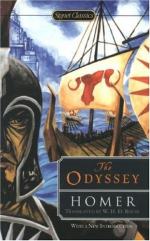|
This section contains 494 words (approx. 2 pages at 300 words per page) |

|
Homer's Imagery
Summary: Describes the vivid imagery Homer uses throughout his epic, The Odyssey. Details how throughout book nine, Homer uses brilliant imagery to describe Odysseus' adventure with the Cyclops, Polyphemus and also when describing the natural world. Considers how the imagery heightens the reader's experience.
Homer intelligently uses imagery to paint dramatic pictures in the audience's mind. Throughout book nine, Homer uses brilliant imagery to describe Odysseus' adventure with the Cyclops, Polyphemus. He also employs vivid imagery when describing the natural world. Another way Homer expresses imagery is by means of comparison.
Homer's dramatic imagery in the Odyssey intensifies Odysseus' adventures throughout the story. For example, in the passage, "Limb by limb he tore them to pieces to make a meal, which he devoured like a mountain lion..." (9, 291-292) Homer uses horrific imagery to intensify the audience's emotional reaction to Odysseus' experience. In this passage, Homer makes a comparison between a lion eating its prey and the Cyclops devouring part of Odysseus' crew, giving the audience an even more visceral image. Another horrifying, but strong, example of intense imagery is, "Their brains ran out on the ground and soaked the earth." (9, 290-292) This...
|
This section contains 494 words (approx. 2 pages at 300 words per page) |

|


